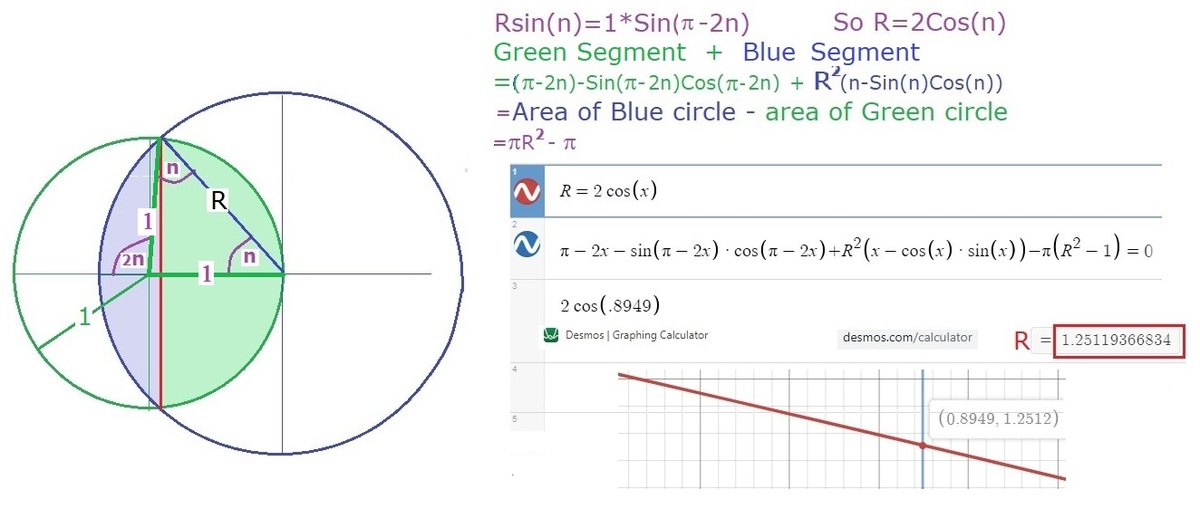Find the radius!
On a field of grass, a lamb is tied to a pole with a 1 meter long rope. After the lamb has eaten all the available grass in the form of a circle, the pole is moved on the circumference of the first circle. How many meters does the new rope need to be, so the lamb can eat the same amount of grass?
Give the solution up to 2 decimals (calculator allowed).
Hint:

The answer is 1.25.
This section requires Javascript.
You are seeing this because something didn't load right. We suggest you, (a) try
refreshing the page, (b) enabling javascript if it is disabled on your browser and,
finally, (c)
loading the
non-javascript version of this page
. We're sorry about the hassle.
3 solutions
great solution, thanks for adding it.
Log in to reply
Glad that you like it. It should be a Geometry problem instead of Calculus one.
I'm struggling to see why the sum you've written equals to 2 π .
I see why the grand total area is 2 π m 2 , but why would that sum also be equal to 2 π ?
Log in to reply
I have recolored the figure. Hope that it helps.
Log in to reply
Ohh, I see it now! Thank you! I'm changing my reaction emoji to "Brilliant"!
The question framing is not correct I think because according to that the lamb should have eaten all the grass covering area of circle with centre O
Log in to reply
The question says, first pole or the center of the circle is at ( 0 , 0 ) and the radius is 1 m. Then the pole is moved to ( 1 . 0 ) as shown in the figure above.
Log in to reply
The lamb has eaten all the available grass in the form of a circle means a lamb has eaten all the available grass in the whole circle the area of which is π ∗ 1 m 2 .

Can you give me solution for the last eq.?
Log in to reply
I used numerical method to solve it. Some problems may not be able to be solve algebraically. I used an Excel spreadsheet to estimate the value r .
plot acos[(2-r^2)/2]+r^2[acos(r/2)]-(1/2) r √(4-r^2)+π-π(r^2) for 1.252>r>1.251
I offer another hint. We note that the total grass area grazed by the lamb is 2 π m 2 . This area is equal to the sum of the area of sector O P R , area of sector Q P R (where r is the length of the rope) and area of quadrilateral O P Q R . In equation, we have:
A O P R + A Q P R + A O P Q R ( π − θ ) ( 1 2 ) + ( 2 π + θ ) r 2 + 2 ( 2 r 1 − 4 r 2 ) 2 ( r 2 − 2 ) sin − 1 2 r + π r 2 + r 4 − r 2 = 2 π = 2 π = 2 π Note that θ = ∠ P O Q = ∠ R O Q = 2 sin − 1 2 r Area of 2 triangles
Solving the equation numerically, we get r ≈ 1 . 2 5 .